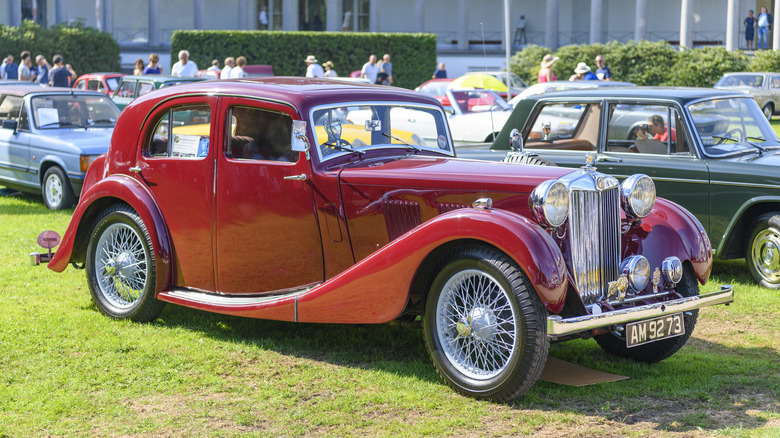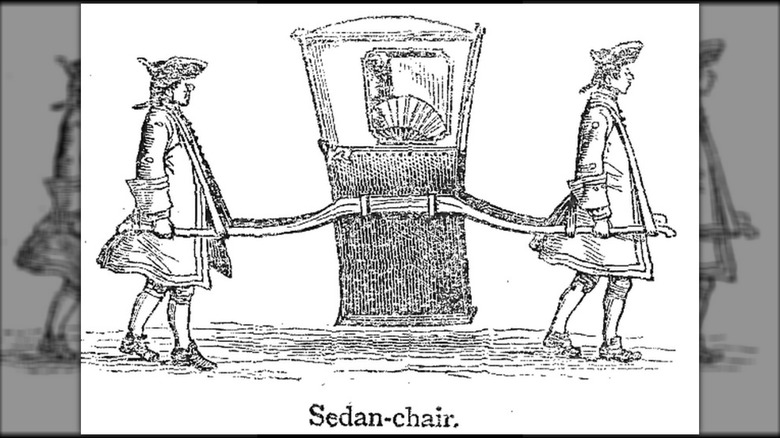
When Americans hear the word "saloon," they're almost always going to think of an old-timey Western bar with double-hinged swinging doors, where cowboys and ruffians of all sorts hung out to quench their thirst. Heck, you can still saunter into one today and grab a whiskey or sarsaparilla. However, a saloon means something entirely different in jolly old England, where the rich tapestry of the Old West was never part of the evolution of its ancient land.
Across the pond, a saloon is a four-door vehicle
made up of three sections. This general blueprint for a closed-bodied automobile with a fixed roof and real doors is called a 3-box design. The driver and passengers sit in a comfortable larger box between two smaller functional boxes located in the front (for the engine) and rear (for the luggage). Thanks to the intricacies of international languages, we have different names for all of those things. In the United Kingdom, the hood is referred to as a "bonnet," while the trunk is called a "boot."
In the end, though, a saloon car is what we call a sedan in the U.S. (a style that no longer sells), and the terms are essentially interchangeable. Brits went with "saloon" over "sedan" (or some other word) as a matter of historical happenstance. In the early 1900s, U.K. car manufacturers began using the term as a way to market automobiles, a term they almost certainly "borrowed" from the train industry, which long had high-end saloon cars where passengers could talk, eat, and drink in a luxurious setting.
Read more: 5 Of The Worst Car Trends We've Ever Seen
A Sedan Was A Covered Chair On Poles

But it's not that simple. The word saloon comes from the French word "salon," which basically means a "living room" or a large room or hall where people would gather. It's a definition perfectly appropriate for what we know it as in the United States — a place where people gathered, albeit to drink, play poker, and have wildly awesome Hollywood Western brawls where they got tossed through those double-hinged swinging doors. Or a place where folks go to get their hair and nails done. Well, it does fit, even if very broadly.
Here's where it gets weirder, again, thanks to the randomness of the international word salad. The word "sedan" appears to have evolved from a confluence of things. First, we have the Italian word "sede," which means "chair" and is derived from the Latin word "sedes," a noun related to the verb "sedere," meaning "to sit." Somewhere in the 1600s, the word "sedan" first appeared and eventually replaced the gangly term used to describe a "covered chair on poles" carried by at least two people (one in front and one in back). This contraption was also known as a "litter."
When these covered sedan chairs made their way to England in the 1630s, King Henry VIII insisted on being carried around in one, and it quickly became the preferred mode of transportation for the rich and famous. Connecting the dots, you can see how this comfortable boxy passenger carrier was the origin point for what would centuries later become the three-box car design.
The English Kept What They Knew

If the term sedan was used in Europe for so long, as a method of transportation no less ... why didn't it stick? As it turns out, it boiled down to timing and a bit of guerrilla marketing mixed in for good measure. Before the mid-19th century, your standard passenger train — while a greater convenience than horseback and covered wagons — was far from luxurious. According to "The Railroad Passenger Car," written by August Mencken, the earliest parlor cars (aka lounge or saloon cars) were created in the 1830s. They helped revolutionize what was sometimes a harsh experience for passengers into one of elegance, complete with comfortable seating and first-class amenities. This new form of luxury travel first appeared in the U.S. on the Erie Railroad in 1843 — just as the "Old West" era was about to kick off.
In the early 1900s, carmakers on both sides of the pond began heavily marketing to the general public, and it's here where their two roads diverged ... at a yellow road sign, perhaps. English auto manufacturers took the "saloon" path (see the classic Jaguar Mark V Saloon as a masterpiece of their craftsmanship), likely because the term was first (and very recently) used on trains that their people already knew meant an opulent form of transportation. The U.S., on the other hand, veered down the road not taken when, in 1911, the Speedwell Motor Car Company in Dayton, Ohio, first used the term "sedan" to market an enclosed, two-door automobile (that technically wasn't a true sedan).
Want the latest in tech and auto trends? Subscribe to our free newsletter for the latest headlines, expert guides, and how-to tips, one email at a time.
Read the original article on SlashGear.















